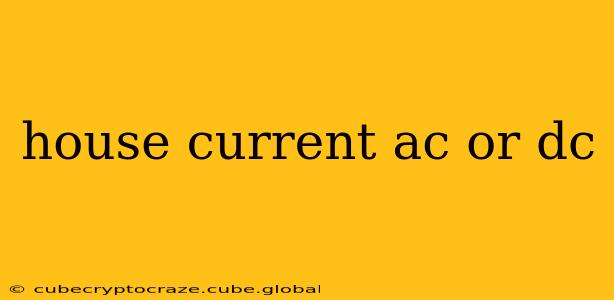House Current: AC or DC? Understanding Your Home's Electrical System
The electricity that powers our homes is alternating current (AC), not direct current (DC). This is a fundamental aspect of electrical engineering that shapes how our appliances and lighting function. But why AC and not DC? Let's delve into the reasons behind this choice and explore some related questions.
Why do houses use AC instead of DC?
The widespread adoption of AC in residential settings is largely due to the work of Nikola Tesla and the advantages AC offers over DC for long-distance power transmission. DC current suffers significant power loss over long distances due to resistance in the wires. AC, on the other hand, can be easily stepped up to high voltage for transmission, minimizing these losses, and then stepped down to safer, usable voltages at the point of consumption (your home). This efficiency made AC the clear winner in the "War of the Currents" at the turn of the 20th century.
What is the voltage of house current?
In most of North America, the standard household voltage is 120 volts AC, while some circuits might provide 240 volts AC for high-power appliances like ovens and clothes dryers. Other parts of the world use different standard voltages, such as 230 volts AC. These variations are due to historical developments and regional standards.
Can I use DC power in my house?
While your home's main electrical system runs on AC, you can certainly use DC power within your home. Many devices, such as smartphones and laptops, use DC power obtained from AC through a power adapter (a wall-wart transformer that converts AC to DC). Low-voltage DC systems are also used for certain applications, such as powering LED lighting strips. However, directly connecting high-voltage DC to your home's wiring is extremely dangerous and strongly discouraged.
What are the differences between AC and DC current?
The key difference lies in the direction of electron flow. In direct current (DC), electrons flow continuously in one direction. This is how batteries work. In alternating current (AC), the electrons periodically reverse their direction of flow, typically 50 or 60 times per second (depending on the regional standard). This cyclic reversal allows for the efficient transformation of voltage levels using transformers, which is crucial for power transmission and distribution.
How does my house get its AC power?
The electricity starts at a power plant, where it's generated (typically using turbines powered by fossil fuels, nuclear energy, hydro, or renewable sources). From there, it travels through a network of high-voltage transmission lines to substations, where the voltage is stepped down. Then, it's distributed to homes and businesses through lower-voltage distribution lines. The entire process involves complex electrical engineering to ensure a safe and reliable supply.
Is it safe to work with house current?
No, it is extremely dangerous to work with house current without proper training and safety precautions. House current can cause severe electrical shocks, burns, and even death. Always consult with a qualified electrician for any electrical work in your home.
This comprehensive overview should answer your core question and address common associated queries regarding household electricity. Remember, safety is paramount when dealing with electrical systems. If you have any doubts or need electrical work done, always contact a qualified professional.
